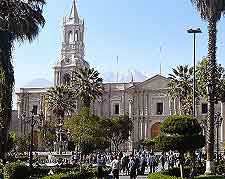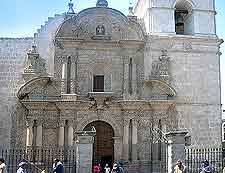Arequipa History Facts and Timeline
(Arequipa, Peru)

Arequipa may not be as populated as
Lima, nor receive as many tourists as
Cusco, but Peru's second-biggest city is certainly amongst the country's most underrated tourist destinations.
While it may lack the Inca ruins and artefacts of most other Peruvian cities, this southern coastal city boasts its own distinct culture and architecture. Most of the signature white buildings which earned Arequipa its affectionate 'White City' nickname were constructed from pale sillar stone, obtained from the three surrounding volcanoes.
First Inhabitants
Stone carvings and cave paintings are the earliest evidence of human settlement during the history of Arequipa, which has been inhabited since the Paleolithic era. The Aruni, the Cabana and the Collagua civilisations who later lived around Arequipa were eventually conquered by the Inca Empire during the 16th century.
The territory's agriculture became a highly developed network of mountain farming terraces fed by elaborate irrigation supplies during the Inca period, in Arequipa's early history. The Inca referred to the region as 'Ariq Qipao', or the 'Land Behind the Volcanoes.' El Misti, the largest and most famous of the 80+ surrounding volcanoes, erupted several times between 1438 and 1471, although it has thankfully been relatively quiet since its last minor eruption more recently in the mid-1980s.
Spanish Occupation
The modern history of Arequipa began when the Spanish conquered and officially established the city in 1540. The Spanish continued to maintain the area's successful Inca irrigation system, while importing their own crops, such as grapevines for wine production and olives for making oil. The sillar volcanic stones used to build many of the city's Spanish colonial buildings helped to protect these unique structures from earthquake damage. Arequipa eventually became one of Peru's most significant economic hubs.

Land of Leaders
Few Peruvian cities embraced independence more than Arequipa, which declared itself the 'Capital of the Republic' at the time of the Montero government. As home of some of the 19th-century independence movement's proudest and most daring leaders, Arequipa became a symbol of the newly independent Republic of Peru and earned another nickname as the 'Land of Leaders'.
Arequipa gained even more power after the 1870 opening of the Southern Railway, which linked this formerly rather isolated city to other coastal communities and thus established new routes for trading.
History of the Modern-Day City
People from across Arequipa's surrounding mountains and highlands flocked to the city, now one of Peru's major dairy producers, during the mid-20th century. More than 150 companies are housed within the industrial park and many of the city's historic sillar buildings have since been converted into banks, hotels, restaurants and other businesses.
A former monastery named La Compania de Jesus is now a modern shopping centre. However, the historic centre of Arequipa is proud to call itself a World Heritage Site and tourism looms large in the economy of the city.
 Arequipa may not be as populated as Lima, nor receive as many tourists as Cusco, but Peru's second-biggest city is certainly amongst the country's most underrated tourist destinations.
Arequipa may not be as populated as Lima, nor receive as many tourists as Cusco, but Peru's second-biggest city is certainly amongst the country's most underrated tourist destinations.